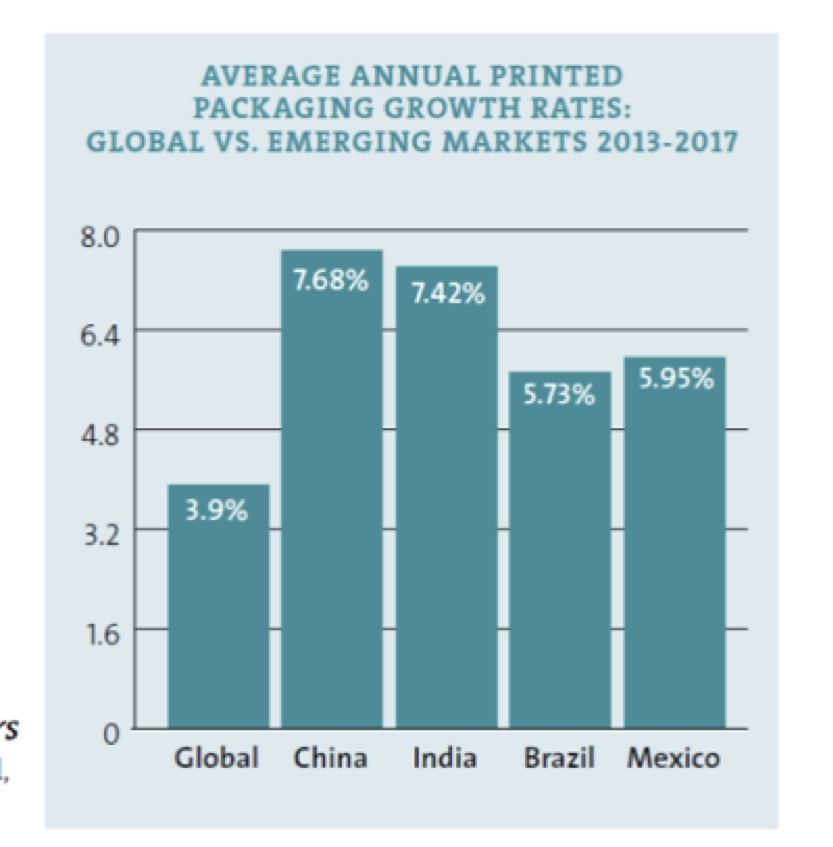Data Points: Packaging in Emerging Markets: Latin America and Asia-Pacific
Approximately 82 percent of the world’s population lives in emerging market countries that account for more than 40 percent of the world’s economy. Economists predict that more than 70 percent of global GDP will come from emerging markets over the next 10 years. As these markets grow and change, there are opportunities for print. A recent PRIMIR study, “Packaging in Emerging Markets: Latin America and Asia-Pacific,” concentrates on regions with the most potential for change—particularly China, India, Brazil and Mexico, with total packaging sales revenues of U.S. $66.7 billion in 2012 as shown in Exhibit 1.
With the ability to deliver the same quality levels as their counterparts in Western Europe and the U.S., the top four emerging markets boast the use of top-of-the-line press manufacturer brands, digital prepress and platemaking in-house. They also utilize automated workflows and Enterprise Resource Planning (ERP) systems tracking waste, runs and profitability.
While delivering the same quality levels, there are notable differences from their Western European and U.S. counterparts. Due to the logistics of importing raw materials from developed markets, consumable goods inventory levels typically average 120-180 days. There is a lack of trained technical personnel, particularly in flexo. And management teams are challenged with handling a company’s revenue strategy in markets that are growing at five to six times the rate of developed countries.
Trade between emerging countries is outpacing developed-to-developed and developed-to-emerging market trade flows. China has replaced the U.S. as Brazil’s most significant trade partner, and in 2010, Brazil surpassed Spain to become Mexico’s fourth-largest export destination.
High-export finished goods, such as electronics, pharmaceuticals and toys, arrive at their destinations entirely packaged. Printed packaging occurs in the country of origin.
While some emerging markets are more export-oriented than others, brand owners and packaging buyer study respondents stressed the importance of securing regional printed packaging supply channels for domestic consumption. In fact, the overriding preference in these markets is for printing to occur in close proximity to where the product is being filled, formed, labeled and bottled.
Emerging markets are projected to deliver annual packaging growth rates at two to four times those of developed markets (Exhibit 2). While each market has its own unique challenges and demands, printers and converters in all emerging markets have similar challenges:
Decreases in average job size (run lengths)
- Finding skilled labor
- Lead time demands
- Print/color consistency from job to job
- Print quality demands driven by globalized print standards
- Raw material price fluctuations
- Access to technical knowledge/education about print manufacturing best practices
Flexo is a growth market across Asia and Latin America in the tag and label and flexible packaging sectors. However, while Mexico and Brazil are well-educated flexo markets, both China and India are nascent markets for flexo; they perceive other print processes to be superior and/or cheaper.
The PRIMIR study demonstrates clear opportunities focused on the unique needs of the emerging market country. The full report, “Packaging in Emerging Markets: Latin America and Asia-Pacific,” is available for purchase. For more information contact Rekha Ratnam, assistant director for market data & research, at rratnam@primir.org. Please visit www.primir.org for more information about this and other PRIMIR research. '
Thanks to PRIMIR for supplying this information.













